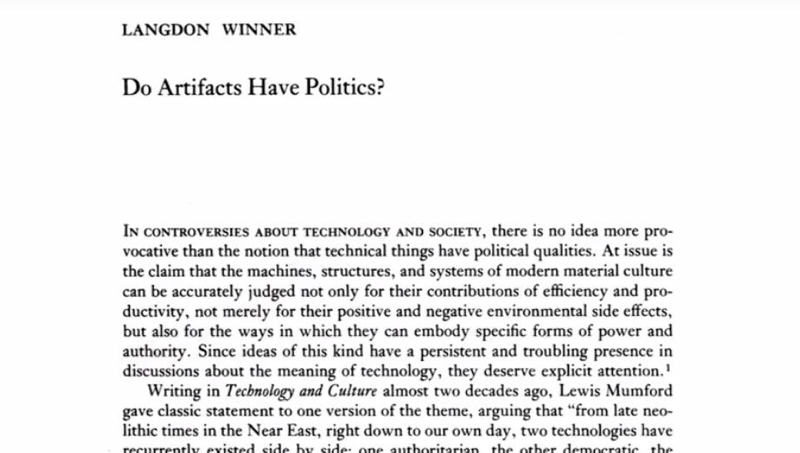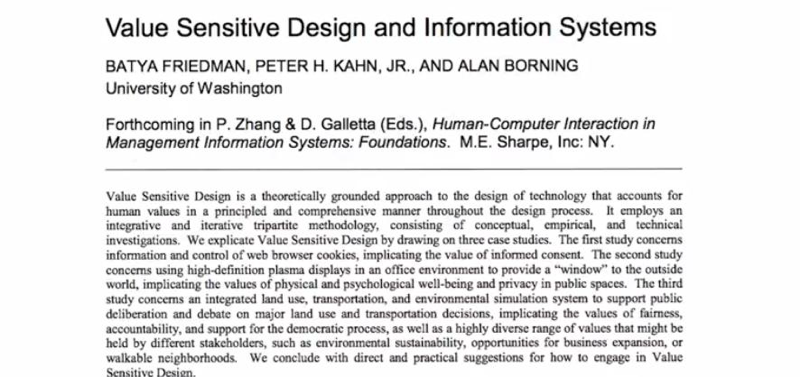- 2.9 Interfaces and Politics
- 2.10 Conclusions to Principles
2.9 Interfaces and Politics
Introduction to Interfaces and Politics

Can artifacts personify specific forms of authority or power, whether for good or bad?- Yes.
How? - artifacts are interfaces that can change the world around us
- by design: we design interfaces to create change in the world.
- or not by design: we design interfaces that are used and affect the world in ways we never anticipated.
Topics of the lecture:
- designing for change
- anticipating the change
- Value-Sensitive Design.
Change: A Third Motivation (of HCI)

Designing for change in response to some value that we have.
- interfaces discourage an unhealthy habit (interface for that habit less usable).
- interfaces serve no usability goals but rather they serve the goal of user safety.
three goals of HCI.
- Help a user do a task,
- understand how a user does a task,
- change the way a user does a task due to some value that we hold, like safety or privacy.
Paper Spotlight: “Do Artifacts Have Politics?”

- Langdon Winner, 1980.
- describes ways that artifacts, demonstrate political qualities and political motivations.
distinct ways in which artifacts can be political:
- inherently political technologies: only compatible with certain political structures due to their design, e.g, nuclear power require authoritarian power structures or solar power are only possible in a more distributed and egalitarian society.
- technical arrangements as forms of order: The technology has no inherent political leanings, but can accomplish some political goals.
Negative Change by Design: In 1990, Robert Moses designed parkway bridges that were too low for public transportations to block poor people from going to the parks he designed for NYC. Positive Change by Design: Facebook’s “like” button and more recently the new emojis are designed to form more positive interaction. Facebook’s set of relationship options and gender options were expanded to include more categories to make people feel more included.
Quiz: Design Challenge: Change by Design
Design an interface that gets Morgan, a desk worker, to move around without remind her to move.
- idea 1: an app that can ring her doorbell automatically
- idea 2: give her water supply at desk, encourage her to drink more water so the will have more water breaks :D
Positive Change by Happenstance: Bijker’s book《 of Bicycles, Bakelites, and Bulbs》, bicycles enabled more individual transportation, also enabled a profound social shift:
- where women don’t need to rely on men for transportation.
- wardrobe change,
Negative Change by Happenstance: Internet access can boom economy but it tends to be installed in the rich/developed areas first. Poor areas/communities are behind not by design but the bi-product of the cost of it.
Value-Sensitive Design
Definition: value sensitive design seeks to provide theory and method to account for human values in a principled and systematic manner throughout the design process.
- Value sensitive design is another dimension to consider: an interface must be useful in accomplishing a task, usable by the user, and consistent with user values?
- privacy by design: preserve that privacy in the design of interfaces
Paper Spotlight: “Value Sensitive Design and Information Systems”

Friedman, Kahn, and Borning together provide this excellent paper on the philosophy.
Three investigations for approaching Value Sensitive Design:
- Conceptual investigations: exploring the role values play in questions like, who are the direct and indirect stakeholders? And how are both classes of stakeholders affected?
- Empirical investigations: exploring how real users make sense of interfaces and answering questions like, how do stakeholders apprehend individual values in the interactive context? And how do they prioritize individual values and usability considerations?
- Technical investigations: targeting the systems instead of the users. and ask the same kind of questions as empirical investigations. Whether or not the systems are compatible with the values of the users?
The fundamental features of value sensitive design.
- value sensitive design should be proactive.
- value sensitive design distinguishes between usability and human values.
Value-Sensitive Design Across Cultures
- values can differ across cultures
- design interfaces that can reach multiple cultures, we need to understand the values of those cultures. (e.g. the rights to be forgotten)
5 Tips: Value-Sensitive Design

- start early. Identify the values early in the design process, and keep checking on them. Values might affect the task you’re trying to support.
- know your users. know your users’ values.
- consider both direct, and indirect stakeholders.
- brainstorm the interface’s possibilities. How the system could be used.
- choose carefully between supporting values and prescribing values. Be careful, and be deliberate about when you choose to support existing values, and when you choose to try to change them with your interfaces.
Exploring HCI: Interfaces and Politics
When design interfaces we need to think about :
- that we can use interface design to invoke positive social change.
- and the possible negative ramifications of our interfaces.
Reversing the Relationship
Technology changes society but society changes technology too. E.g.
- in 1938, General Electric’s new energy efficient light caused the power companies’ boycott.
- policies nowadays prevent technologies from combining content consumption into one channel.
Conclusion to Interfaces & Politics
In this lesson, we’ve discussed:
- the different ways in which interfaces interact with existing power structures or political motivations.
- negative reperussions, either by design or by happenstance.
- positive impacts intentionally or accidentally.
- Value sensitive design: it’s important to keep in mind different cultures values while designing interfaces.
- user experience exists not only in individuals and groups but in societies.
2.10 Conclusions to Principles
2.10 is a summary of lessons 2.01 ~ 2.09, the notes for those lessons are listed below, so there will be no notes for the lecture.
-
[HCI 笔记 Week 01] (欠奉) -
[HCI 笔记 Week 03 Direct Manipulation and Human Abilities](https://www.jianshu.com/p/3a8d3a68571a) -
[HCI 笔记 Week 05 Design Principles and Mental Models](https://www.jianshu.com/p/9b0b1e29b2a0) -
[HCI笔记 Week 07 Task Analysis And Distributed Cognition](https://www.jianshu.com/p/e8edd4910811) - 本篇
2018-07-14 初稿